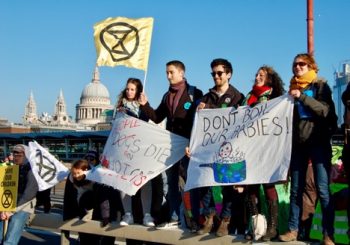- The latest IPCC reports predict that, unless we decarbonize rapidly, we could face ecosystem and even societal collapse by the end of the century.
- In response, disruptive climate protests in the UK are blocking roads, bridges, and buildings, in an attempt to get the UK government to declare a climate emergency and commit to a carbon neutral Britain by 2025.
- The protest group responsible—Extinction Rebellion—has sprung from apparently nowhere in a matter of months, and aims for nothing less than global civil disobedience to pressure governments across the world to act on climate breakdown and species extinctions.
- This post is a commentary. The views expressed are those of the author, not necessarily Mongabay.
“A 4 degrees C future is incompatible with an organized global community,” climate and energy professor Kevin Anderson once told Grist.
Even if we cut emissions by 3.5 percent a year after 2020, we’ll hit 4 degrees Celsius warming by the end of this century. Just let that sink in for a minute. When babies born now are in their 80s, there could be no human civilization left to speak of. The Amazon rainforest is likely to die at 3-4°C of warming. And the corals? They’ll be long gone, dying out at 2°C. Currently, perversely, terrifyingly, global emissions are still rising.
If that is what we are facing, why are we all carrying on as normal? Well, some people aren’t. Extinction Rebellion is a UK-born group committing civil disobedience to protest catastrophic climate breakdown and species extinctions. Springing apparently from nowhere, in November 2018 the group mobilized thousands of people to block bridges, roads, and government departments in London—trying to cause enough disruption to make the British government act on climate. Extinction Rebellion demands that the UK government declare a climate emergency, that the UK go carbon neutral by 2025, and that the decisions on how to go carbon neutral are taken by a citizen’s assembly.
With their use of stark hourglass and human skull imagery, their emotive wording, strong demands, and tactics of civil disobedience, Extinction Rebellion activists have raised hackles in many quarters. Here I explore some of the reasons why this group has taken the approach it has, and assess some of the criticism it has faced.

The author, Dr. Claire Wordley (right), joins Extinction Rebellion protesters blocking Blackfriar’s Bridge. Diner Ismail waves the Extinction symbol, an hourglass inside a circle representing the planet, over St. Paul’s Cathedral in the background. Photo Credit: Jane Carpenter.
They’ve picked the wrong target! The UK government is doing excellent work to stop climate change. (Roger Harrabin, BBC environment analyst)
First, while this protest is starting in the UK—home of the Industrial Revolution, for those that like symbolism—this movement is growing worldwide. So far chapters have been set up in Germany, Scotland, Ireland, Denmark, Belgium, Sweden, Spain, Colombia, Tasmania, France, and the USA, and more are sprouting up every day.
Second, the body advising the UK government on climate breakdown is clear that unless huge changes are made, the government will miss its own legally binding targets. Yet the government is approving new runways, encouraging domestic flights(in a small country well served by rail), and allowing hydraulic fracturing (fracking) for gas despite public protests; while simultaneously scrapping subsidies for renewables, cancelling funding to develop carbon capture schemes, and rejecting plans for a tidal lagoon generator as “too expensive.”
Third, the UK government’s own legally binding targets on emissions won’t keep it in line with the Paris Agreement, where nations agreed to keep “well below” 2°C of warming, and ideally under 1.5°C. This led to a legal challenge against the UK government by Plan B and eleven British citizens, who argued that the UK was in breach of its own international obligations. It is still unclear whether the case will be heard.
Fourth, the UK’s carbon reduction targets apply only to the emissions created on UK soil, and not the carbon it imports via goods and services, or carbon released on flights to or from the country. As a nation that buys a lot of manufactured goods (which produce emissions during manufacture) from other countries, and whose people fly a lot, we need to factor these into our emissions targets. This excellent graphic shows how even as territorial emissions fell, emissions from imports rose until the global recession—and the government’s own analysis shows the UK’s carbon footprint rising again slightly in recent years if imports are included in the analysis.
And finally, there’s the moral argument. The UK has been pumping greehouse gases into the air for a very, very long time–the accumulated impacts of which are huge (remember the industrial revolution was born here). Nations industrializing today need help to decarbonize, but as a rich, developed nation, the UK has a “carbon debt” to repay to the world for its past emissions. Taken together, it seems to me that my government is a very fair target to protest against.
But what’s the point in the UK doing anything when China is polluting so much? (One of the most common arguments on Twitter, in the comments section of the Daily Mail, and one I hear surprisingly often among conservationists.)
I’m not going to spend too long on this one as it is not specific to Extinction Rebellion, but it seems to come up every time the UK/USA/Australia is criticized for not doing enough to reduce emissions. Yes, emissions in China are rising. This is not good. But let’s take a look at the amount of goods the UK (and other developed nations) import from China—this handy graph shows how it has increased over time. If we want China to pollute less, we need to import less from them, demand stricter environmental and workers rights regulations on what we do import, and support them to make a clean energy transition. Further, let’s remember that they are doing better than the UK in some ways; for a start by building two-thirds of the world’s solar panels.
Per capita, China’s emissions are about the same as the UK’s; and as stated above, the UK has a historic carbon debt to repay. The UK could become a leader in doing its bit, reducing emissions, developing technologies, economies, and political systems that set a blueprint for the world to follow in avoiding catastrophic climate change. Or, it could whine about China until the seawater closes over London.
Extinction Rebellion’s 2025 target is an unrealistic timeframe for the UK to aim for carbon neutrality (as reported by Roger Harrabin, BBC environment analyst).
Firstly, it’s hard to tell what is realistic or not; a lot of that depends on political will. But while 2025 is very close, Extinction Rebellion activists are not the only ones with big ambitions. Norway is aiming for carbon neutrality by 2030, Costa Rica by 2021. Even Ethiopia has ambitions to be carbon neutral by 2025. These countries may or may not make it, and these targets don’t appear to include imports—but if they try hard enough, these nations are likely to make significant advances in cutting emissions.

Banner on Blackfriar’s Bridge explains the severity of the situation using science. Photo Credit: Diner Ismail.
The UK and other countries made huge changes during World War Two, when everyone was asked to “do their bit” to save the country. Think of the “Dig for Victory” campaign that got people digging up their gardens to grow vegetables, the rationing, the push for factories to start building planes and tanks, the farmers who became fighter pilots, and the housewives who became farmers and factory workers. Imagine if we had a push now showing people that to keep their kids safe they should start growing more of their own food and eating less meat; imagine if World War Two-levels of effort were invested in renewable energy, in making public transport better, in swapping petrol pumps for electric car charging stations, in covering rooftops with solar panels. Huge changes are needed, but people have made huge changes before, and what we face now is much scarier than World War Two.
The will of the people to tackle climate breakdown is also greater than politicians might think. A 2017 survey of over 8,000 people in eight countries found that 84 percent agree to at least some extent that climate change is a “global catastrophic risk,” and almost 90 percent agree that we should probably or definitely take climate action “even if it requires making considerable changes that impact on our current living standards.” But people are unlikely and often unable to do it alone–they need a solid green infrastructure that makes behavior-change possible.
Cognitive scientist George Lakoff says that “political ground is gained not when you successfully inhabit the middle ground, but when you successfully impose your framing as the ‘common-sense’ position.” Bristol City Council in the UK recently voted to declare a climate emergency and to make the city carbon neutral by 2030—and used the rise of Extinction Rebellion as a sign that people were ready. The district of Stroud quickly followed suit. While the UK target is 80 percent domestic emissions cuts by 2050, in these cities the framing is getting closer to that of Extinction Rebellion. The UK government is currently asking the Committee on Climate Change whether it needs tougher targets—sufficient public pressure could make zero carbon by 2025 the option everyone is talking about.

Claire shares a joke with protestor Phil Kingston, 82, who was later arrested for refusing to leave the bridge. He has been arrested at least three time with Extinction Rebellion, saying “I have four grandchildren and nothing is more important to me than their security. And that security is being eroded all the time by an economy that is pumping fossil fuels in the air when already we are heading for disaster. I’m not accepting it. I don’t mind going to prison.” Photo Credit: Jane Carpenter.
Extinction Rebellion’s demands are too vague. They need to take a stronger political stance! (Chris Saltmarsh at Novara Media, James Butler at The Guardian)
Various commentators have suggested that Extinction Rebellion needs to team up with the Labour party, to explicitly embrace socialism, or to explain exactly how we get to carbon neutral. While I understand the sentiments, these analyses miss what it is that has made this movement so appealing: the framing is moral, not political. By joining forces with a political party or adopting an explicit approach, they will lose all of those people who don’t think exactly like that. The climate emergency is bigger than party politics, bigger than socialism vs capitalism, and requires all of us—left wing, right wing, urban, rural, rich, poor, socialist, capitalist, religious, atheist—to come together.
The messaging may be stark but the movement is very open; I am constantly amazed by the diversity of people I meet through Extinction Rebellion; Christians, atheists, primary school teachers, professors, software developers, farmers, parents, students, and many more. “Solutioneering” by taking explicit stances (pro-or anti-nuclear, pro-or anti-onshore wind, pro-or anti-stopping meat production, etc.) could also alienate people. That’s the power of the citizen’s assembly idea: that we decide together how to fix the problem. But first we need to get the governments to declare that there really is a serious problem, and not just fall back on “we will adapt.”
Why do you need to commit civil disobedience? Just have a march! (The Daily Mail; I’ve also heard this from conservation colleagues, and the Extinction Rebellion flyers I put up in the Cambridge Conservation Initiative were taken down, where those for regular marches were not.)
Since the declaration of scientific consensus that humans were causing global warming in 1988, there has been a huge array of tactics used to try and get emissions cut. Scientists have produced report after report and citizens have signed petitions, held marches, and even taken legal action against their governments. Yet emissions have continued to rise. While people working to limit climate breakdown have gone through the “proper” channels, lobbyists for fossil fuel companies are less principled. They have directly lobbied governments (the UK department responsible for energy and climate change met with fracking companies 30 times in 3 years; it never met any anti-fracking campaigners who tried to talk). They have funded think-tanks that spread misinformation on the climate emergency, they have muted concerns about the emerging crisis through media outlets, they have sat hand-in-glove with governments and refused to change their ways even as the biosphere crumbles. They have even been complicit in the execution of their critics. And so, along with complicit governments, they have convinced people to carry on as normal.

At 1.5 degrees centigrade we will likely lose 70-90% corals; at 2 degrees, we will lose 99%. We are likely to reach 2 degrees by 2050, at which point Nemo may only live in aquariums. Photo Credit: Lydia Instone.
Those protesting against fossil fuels do not have the same money and lobbying power, so rely on grassroots organizing. Marches agreed to in advance by governments have not had sufficient impact. Civil disobedience aims to disrupt: to disrupt economic activity, drawing the media and the governments’ attention, and to disrupt normality, to try and show other citizens that things are not OK. Humans are herd animals; if we see people rushing for the exit, we’ll follow. We can’t rush for the exit to planet Earth, but we can try to create a crisis atmosphere that may engage others to act. Civil disobedience requires remarkably few people to be effective; even just 3.5 percent of the population engaged in sustained non-violent resistance can topple brutal dictators.
Civil disobedience for the climate is taking off across the world, especially among the very young, who cannot vote yet but who will be worst affected by the climate crisis. The Sunrise Movement and the Youth Rising movements are “sitting in” and refusing to leave seats of power in the USA and Canada. In the USA, they seem to be having some influence in pressuring Democrats to draw up a “Green New Deal.” Inspired by 15-year-old activist Greta Thunberg, thousands of brave and switched-on children are committing civil disobedience by going on strike from school in Sweden and Australia, and clearly scaring their politicians. Imagine if more of us walked out from school, from university, from work, from whatever we are expected to do, demanding climate action.
Imagine cities brought to a standstill. This is part of what Extinction Rebellion hopes to achieve in its International Day of Rebellion in April 2019. If the prospect of a 4-degree world won’t make you take action, what will?
The Extinction Rebellion messaging is offputting/polarizing/not very optimistic (Twitter, several conservationists, The Daily Mail).
Extinction Rebellion’s messaging and imagery has been stark, even brutal. Hourglass symbols remind us that time is running out, human skulls tell us that people will suffer with climate breakdown, and the black capital letters on their banners spell out bleak messages. CLIMATE CHANGE = MASS MURDER. SAVE OUR CHILDREN. ACT NOW. These have been off-putting to some people in their bleakness, but in general the tone fits the advice of Australian psychologists who produced a report on motivating people to act on climate breakdown. “Don’t Mention The Emergency” draws on research from a range of health and other behavioral campaigns, and argues that we need to evoke fear, anger, hope, and courage to motivate mass movements for a safer global future.
While communicating climate breakdown is complex and cannot be reduced to a simple formula, psychologists behind the “Don’t Mention the Emergency” report draw on results from healthcare and social justice campaigns to recommend strong wording. The authors explain that while most people believe in climate change, they have a tendency to ‘average’ the messages they hear—calm facts and figures on one side, angry denial on the other—and end up somewhere in the middle. In the middle, people feel like they should switch the lights off when they leave the room, but they are not energized to demand stronger climate policies. By using emotive language to make it clear that this is an emergency, you can draw the “average” position closer to the truth.
The report tells us that over-optimistic messages can backfire and make people less motivated; we need to use words like “climate emergency” and “human suffering.” It emphasizes the need to tell people the Earth is already too hot, that we are risking the lives of billions of people, and that civilizational breakdown is looking like a real possibility this century. The report also recommends making people angry at the immoral billionaires who got us into this mess. Researchers argue that “contrary to a simplistic view of anger as destructive, research shows that anger is typically the emotion most strongly associated with motivating individuals to rectify social injustices.” We need to show people that solutions exist, if we just have the courage to make our governments upset those immoral billionaires by implementing those solutions. Calling for government action, as Extinction Rebellion does, rather than asking people to make individual choices, has been shown to be a better-supported message even among people who are less certain that climate change is a serious threat. (It also addresses the key structural drivers of fossil fuel dependency, so if it works, it will have far bigger impacts.)
Ultimately, the success or otherwise of Extinction Rebellion’s messaging will lie in the amount of people it can mobilize, and the actions that governments take directly or indirectly as a result of mass civil protest. So far, Extinction Rebellion has managed to motivate thousands of people in the UK in a short amount of time, and inspired the set-up of other chapters across the world. This suggests that its message has resonated with many people. But this is only the beginning—it’s over to you now.
In 30 years time, what will you say you did for the climate?
Dr. Claire Wordley is a researcher with the Conservation Evidence group at the University of Cambridge. Her background includes working on the responses of tropical bats to forest fragmentation and agricultural activity. This led to an interest in researching how to make conservation change happen, and she now works at Conservation Evidence working with NGOs and government agencies to see how they can best use and produce scientific evidence.


